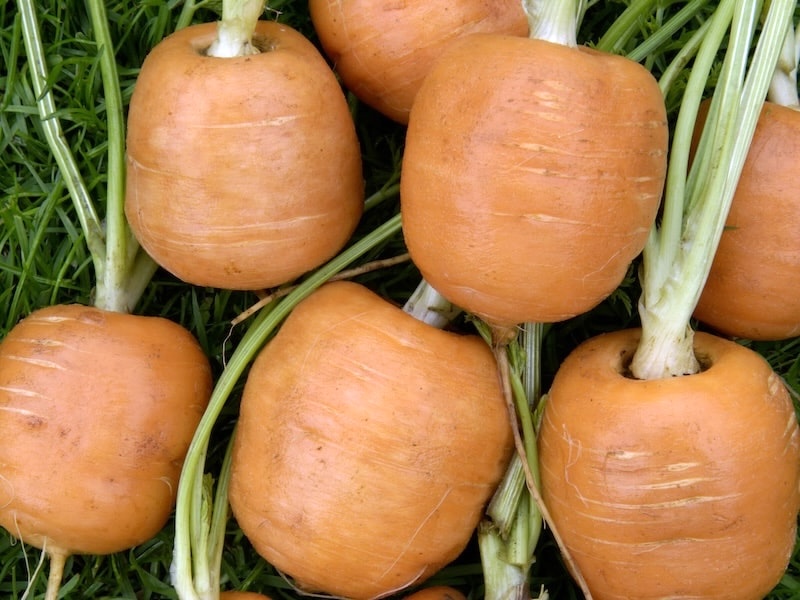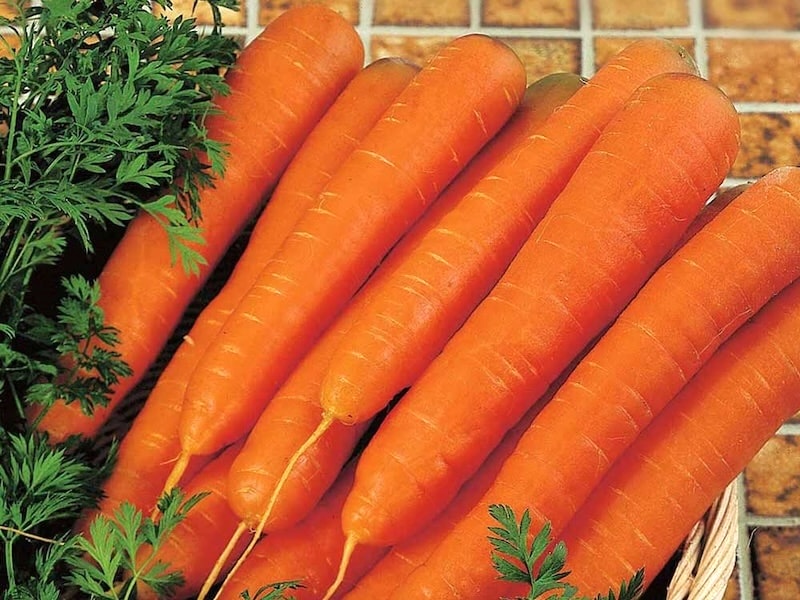Sowing and growing carrot seeds is a quick and easy way to produce a healthy crop of delicious roots. The most important part of the process is preparing the soil. We asked experienced allotment grower Lee Senior for his top tips on how to grow long straight carrots while deterring the dreaded pest – carrot fly. Here’s his tried-and-tested advice.
Browse our full range of carrot seeds for inspiration.
Choosing the best carrot variety to grow
I enjoy growing early and out of season crops where possible. My go-to choice for early sowings is Carrot ‘Amsterdam Forcing 3’. As the name implies, this is an early variety perfect for sowing during late winter or early spring under cloches, cold frames, or in containers or raised beds where you’ve pre-covered the soil. It can be harvested as finger-sized carrots which are ideal for stir fries and salads.
Carrot ‘Autumn King 2’ is my preferred variety for late-season sowing (until mid-July). This timeless, late-maturing variety stores really well. It’s incredibly reliable and the roots are of excellent quality.
If purple carrots are your thing, then ‘Purple Haze’ is the one to go for. This is the first hybrid purple maincrop variety, and it’s guaranteed to be a talking point for children and adults alike! For another unusual choice, a packet of ‘Rainbow Mix’ carrot seeds contains a wonderful array of gold, orange, purple and red roots. There’s something for everyone and it’s a good way to get kids interested in growing.
And if carrot fly is a problem in your area, then try growing F1 ‘Resistafly’. This vigorous, excellent-tasting carrot has some resistance to the destructive larvae. If eggs are laid by the adult fly, damage is far less severe than attacks on other varieties.
How to sow carrot seeds

Image: Carrot Seeds ‘Autumn King 2’ from Suttons (©Floramedia)
Carrot seeds should be sown in the same way as other seeds – there are no special requirements. If you’re starting them off under cover, use containers, large pots or cold frames filled with multi-purpose or seed compost. Sow the seed thinly just below the surface at a depth of 1.5cms (half an inch) and cover with a light layer of compost or vermiculite.
Carrots can be sown directly outside from April (or once the soil warms up sufficiently) until mid-July, depending on the variety. Good soil preparation is key and is time well spent. Either rotovate or work the soil into a fine tilth, removing weeds and large stones as you go.
Sow the seed thinly in drills to a depth of up to 1.5cms ( half an inch) until mid-July. It can be beneficial for germination if the seed drill has a layer of multi-purpose compost in the bottom. Water the seed drills prior to sowing if the soil is very dry.
Cover the seed with a thin layer of multi-purpose compost or very fine soil. If the weather is cold after sowing, cover the rows with a layer of frost protection fleece.
Your rows should be 15cms (6 inch) apart or a little greater if space allows. The seed should be sowed where you intend the plants to grow on to maturity without disturbance.
Where to grow carrots

Image: Carrot Seeds ‘Rainbow Mix’ from Suttons
Carrots prefer fertile soils that are not too nitrogen-rich. Fine soils or a good loam are best. They dislike heavy clay and freshly-manured soil which can cause the roots to fork and become misshapen.
It’s a fallacy that soil intended for carrots has to be sandy. Sandy type soils are fine, but this doesn’t have to be the case. Just avoid using stony soil as this will cause the roots to become misshapen. If your veg patch is stony, use a sieve to rid it of as many stones as possible or grow stump-rooted carrot varieties that require far less depth of good quality soil. Stump-rooted varieties or ‘short’ varieties of carrots can be grown in window boxes too.
Carrots can be successfully grown to maturity in large pots in greenhouses or polytunnels. I’ve even seen show-winning carrots grown in dustbins! If you start them undercover, seed can be sown as early as late-February.
How to plant carrots

Image: Carrot Seeds ‘Rondo’ from Suttons (©Photoshot)
Carrots don’t like disturbance under any circumstances – sow them where you want them to grow. They’re not normally transplanted as this can damage the tap root, causing the carrot to become misshapen.
No matter how I’ve tried over the years, most transplants result in damaged or wonky carrots! Of course they can still be used in the kitchen and they taste exactly the same!
If you need to thin your rows of carrots, pull the small, delicious, finger carrots to use in salads and stir fries. This gives the remaining plants more space to grow on and develop into a larger size.
How to care for carrots

Image: Carrot Seeds ‘F1 Resistafly’ from Suttons (©Floramedia)
Excitingly, with careful use of varieties and good storage conditions, it’s possible to have carrots almost all year round. I regularly harvest late-summer sown varieties such as ‘Autumn King 2’ over winter and even early the following spring if grown in containers containing multi-purpose compost. They can simply be left in situ in the container until needed if protected from frost and harvested as required a few at a time. Here are my care tips:
- A balanced, slow release fertiliser such as blood fish and bone should be added to the soil or container before sowing.
- The main pests are the destructive maggots of the carrot fly which can do untold damage as they tunnel into the root when they hatch out of the eggs laid by the adult fly.
- To deter carrot fly, try to minimise the smell of the carrots. If you need to thin your carrots, only do so on still evenings when the adult flies are less likely to be attracted by the smell of the carrot foliage.
- The barrier method will stop the flies laying their eggs close to the host plant and, if done effectively, this will prevent attack. If you completely cover the rows of carrots with very fine mesh or fleece and bury the edges in a small trench all the way around, this should act as a deterrent.
- Companion plantings of strong smelling alliums such as garlic may help disguise the smell of the foliage and fool the adult fly.
- Seed sowings made from early-June onwards are less likely to be attacked, due to the life cycle of the adult fly.
- Alternatively choose a variety with some resistance to attack. While complete resistance isn’t likely, generally attacks should be less severe.
We hope we’ve inspired you to grow your own carrots or helped to troubleshoot problems. Expensive to buy in the supermarket, this luxury perennial vegetable tastes infinitely better when picked and eaten on the same day from your own garden! Find more of Lee’s practical, hands-on, vegetable growing advice over at his monthly allotment pages.
Image: Carrot Seeds – Early Nantes 5 from Suttons (©Thompson & Morga)
Last Updated on December 11, 2024 by Suttons Horticultural Team




